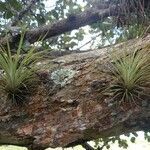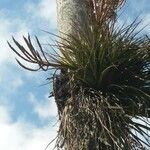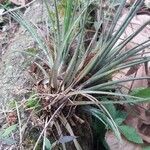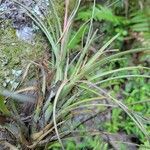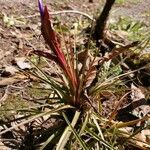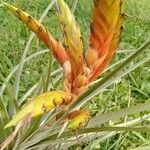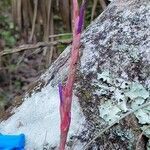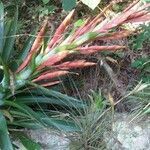Plant acaulescent, including inflorescence to 55 cm long, with a narrowly crateriform, 30-40 cm tall rosette of many cinereous leaves. Leaves rigid-coriaceous, 25-45 cm long, about equaling or shorter than the inflorescence; sheaths ample, contracted into the blade (ob-)ovate, 3.5-7 x 2.2-4.5 cm, very densely brown-punctulate-lepidote, appressed-lepidote at the apex, brown or castaneous for most part; blades suberect or arching, sometimes secund, very narrowly triangular, often involute-subulate toward the apex when dry, obscurely carinate, 20-35 x 2-3 cm, long-attenuate, pungent, densely appressed-lepidote, cinereous. Inflorescence simple or digitately compound of 2-4 spikes, 33-47 cm long; scape erect, 10-25 cm long, 0.5-1 cm in diam., glabrous, concealed by the bracts and leaves; scape bracts erect, very densely imbricate, the lower ones foliaceous, the upper ones more ovate and caudate, exceeding the scape with the blades; axis very short(?); primary bracts as the upper scape bracts, (sub-) erect, much shorter than the spikes; spikes subsessile, lanceolate, complanate, 8-20 x 2.3-3.5 cm, acute, densely and distichously 5-17-flowered, with 4-10 more or less reduced sterile bracts at the base and one or a few at the apex; rachis entirely hidden, straight or sometimes curved, sharply angled when dry, glabrous; floral bracts erect, very densely imbricate, rigid-coriaceous, with even or faintly veined surface when dry, elliptic, 4.5-5.5 cm long, about 5-8 times as long as the internodes, much exceeding the sepals, with broad membranaceous margins, acutish, slightly incurved at the extreme apex, the upper ones half sharply carinate, glabrous except for the extreme apex, lustrous-green often tinged with rose, or yellowish. Flowers tubular-erect, sessile; receptacle thick, ca. 2 mm long; sepals (sub-)coriaceous, with even surface, lanceolate, 3.3-4 cm long, with broad veinless margins, acutish or obtuse, posterior ones about 2/3 connate, distinctly carinate and incurved at the apex, glabrous; petals linear, with obovate-oblong blade, rounded, to 6 cm long, blue, violet or rarely white; stamens exserted, the longest 3 exceeding the pistil by half of the anthers, filaments slender, flat, exserted part dilated and subterete, anthers dorsifixed (at 2/5), linear, ca. 6 mm long, free basal lobes ca. 0.5 mm long, with emarginate apex; ovary slender ellipsoid, contracted in the slender style, stigma cuneate, obscurely lobed. Capsule cylindric, just exceeding the sepals, ca. 4 cm long, attenuately acute or rounded and short-beaked.
More
Plants clustering, flowering to 65 cm. Stems short. Leaves 20--50, many-ranked, erect to spreading, gray to gray-green, 25--50 ´ 1--2.5 cm, grayish-scaly; sheath dark rust colored toward base, broadly elliptic, flat, not forming pseudobulb, 3--4 cm wide; blade narrowly triangular, tapering evenly from base to apex, stiff, leathery, channeled to involute, apex attenuate. Inflorescences: scape conspicuous, erect or ascending, 10--35 cm, 4--8 mm diam.; bracts densely imbricate, erect to spreading, like leaves but gradually smaller; sheath of bracts narrowing gradually into blade; spikes erect to spreading, densely palmate to laxly 2(--3)-pinnate, narrowly elliptic, compressed, 5--20 ´ 1.5--2.5 cm, apex acute; lateral branches 3--15. Floral bracts imbricate, erect, red, red-yellow-green, or green, broad (covering all or most of rachis, rachis not visible at anthesis), elliptic, keeled, 2--4.8 ´ 1.2--2 cm, thin-leathery, base not visible at anthesis, apex acute, surfaces glabrous or slightly scaly toward apex, venation even to slight. Flowers 10--50, conspicuous; sepals with adaxial pair connate, lanceolate, to 1/2 keeled, to 4.2 cm, leathery, slightly veined, apex acute, surfaces glabrous to slightly scaly; corolla tubular, petals erect, violet (white), ligulate, 5--6 cm; stamens exserted; stigma exserted, conduplicate-spiral. Fruits to 4 cm.
Plant 2-10 dm. high. Leaves rosulate; sheaths large, ovate, dark castaneous; blades narrowly triangular, 2-3 cm. wide, finely lepidote. Scape erect, stout. Scape-bracts imbricate, the lower ones foliaceous. Inflorescence simple or digitate. Primary bracts broadly ovate, acuminate, shorter than the spikes. Spikes sessile or subsessile, erect, bearing reduced sterile bracts at base, usually over 1 dm. long, strongly complanate. Floral bracts imbricate, broad, acute, 2-4 cm. long, carinate, nearly or quite even, coriaceous, glabrous or subglabrous. Sepals usually shorter than the bracts, the posterior ones connate. Petals 6 cm. long, white to purple. Stamens exserted.
